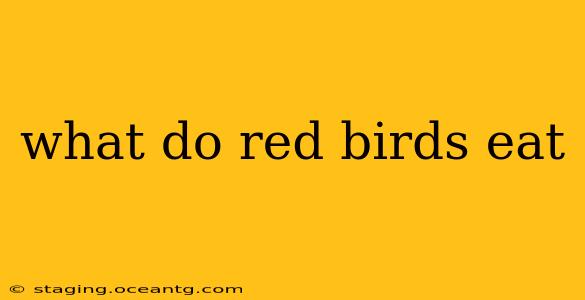Many bird species boast vibrant red plumage, captivating bird watchers worldwide. But what do these striking red birds eat? The answer, as you might expect, isn't a one-size-fits-all solution. Their diets vary significantly depending on the specific species, their habitat, and the season. This guide explores the feeding habits of several common red birds, answering frequently asked questions along the way.
What do Northern Cardinals eat?
The Northern Cardinal, a common backyard visitor in North America, is a popular example of a red bird. These birds are omnivorous, meaning they consume both plant and animal matter. Their diet varies seasonally:
- Summer: Insects form a significant portion of their summer diet. They're adept at catching grasshoppers, beetles, caterpillars, and other insects, providing essential protein for breeding and raising young.
- Winter: As insect populations decline, Northern Cardinals rely more on seeds, berries, and fruits. Sunflower seeds are a particular favorite, making them a popular addition to backyard bird feeders. They'll also forage for weed seeds and berries found on shrubs and trees.
What do Red-bellied Woodpeckers eat?
Despite their name, Red-bellied Woodpeckers aren't entirely red; they have a reddish wash on their belly. These woodpeckers are insectivores, primarily feeding on insects they find in trees. Their diet includes:
- Insects: Ants, beetles, and wood-boring insects make up the bulk of their diet. They use their strong beaks to excavate insects from bark and wood.
- Fruits and nuts: They'll supplement their diet with fruits and nuts, particularly in the winter months when insects are scarce.
What do Summer Tanagers eat?
Summer Tanagers are vibrant red birds found in the eastern United States. They are primarily insectivores, with a diet that includes:
- Insects: They consume a wide variety of insects, including beetles, wasps, and caterpillars. They often catch insects in mid-air or glean them from leaves.
- Fruits: They also consume fruits and berries, particularly during the fall and winter months.
What do Scarlet Tanagers eat?
Similar to Summer Tanagers, Scarlet Tanagers are also primarily insectivorous. Their diet consists largely of:
- Insects: A variety of insects, similar to the Summer Tanager's diet.
- Fruits and berries: They will also consume fruits and berries, particularly during migration and winter.
What kind of food should I put out for red birds?
Offering a variety of foods in your backyard will attract a broader range of red birds. Consider providing:
- Sunflower seeds (black oil sunflower seeds are preferred): A high-energy food source favored by many species.
- Nyjer seeds: Small seeds popular with smaller birds.
- Suet: A high-fat food source, particularly beneficial in winter.
- Fruits (berries, apples, oranges): Provide added variety and attract fruit-eating birds.
- Mealworms (live or dried): A great source of protein, especially helpful during breeding season.
Do red birds eat nectar?
While some red birds might occasionally sample nectar, it doesn't form a significant part of their diet. Hummingbirds are the primary nectar-feeding birds.
What are the predators of red birds?
Red birds, like all birds, face various predators depending on their location and habitat. Common predators include:
- Cats: Both domestic and feral cats pose a significant threat.
- Hawks and owls: These birds of prey are natural predators of smaller birds.
- Snakes: Some snake species prey on birds' eggs and nestlings.
This guide provides a comprehensive overview of what red birds eat. Remember that the specific diet of a red bird depends greatly on its species and its environment. By understanding their dietary needs, we can better appreciate these beautiful creatures and create habitats that support their survival.
